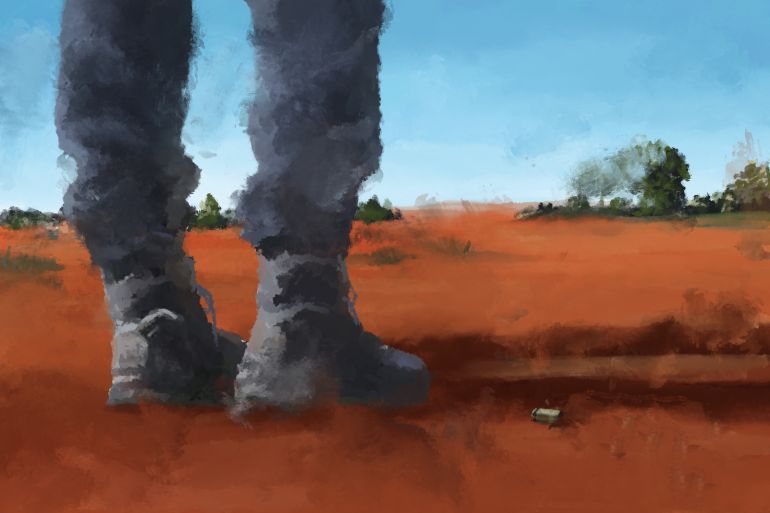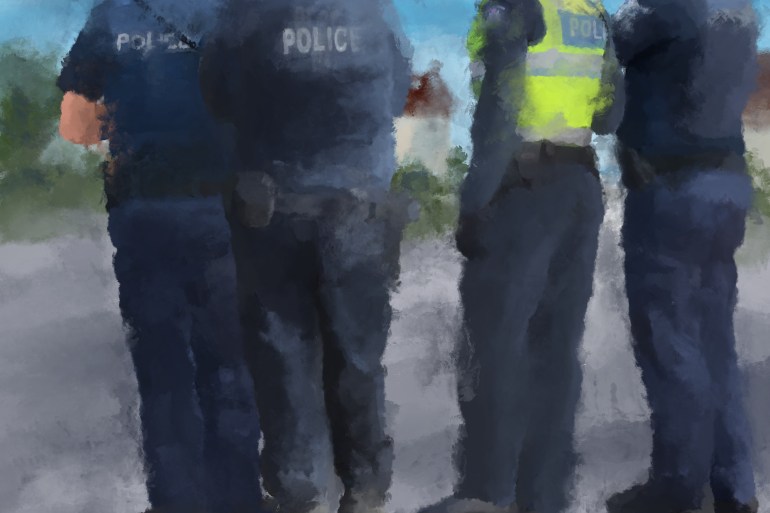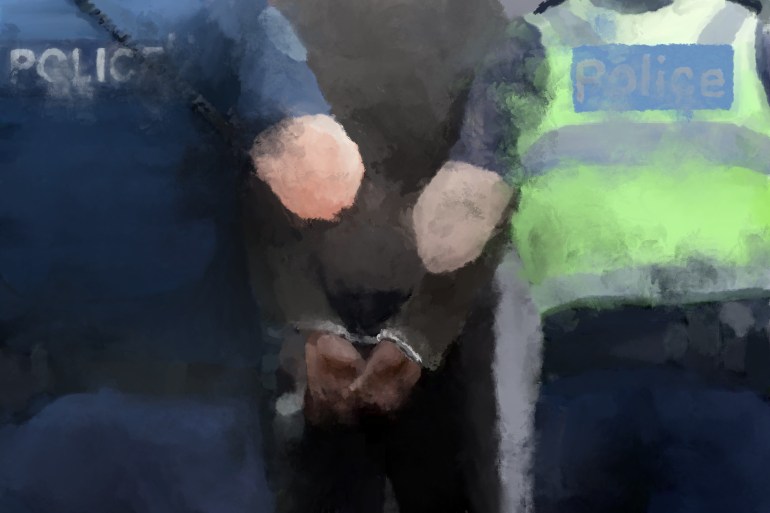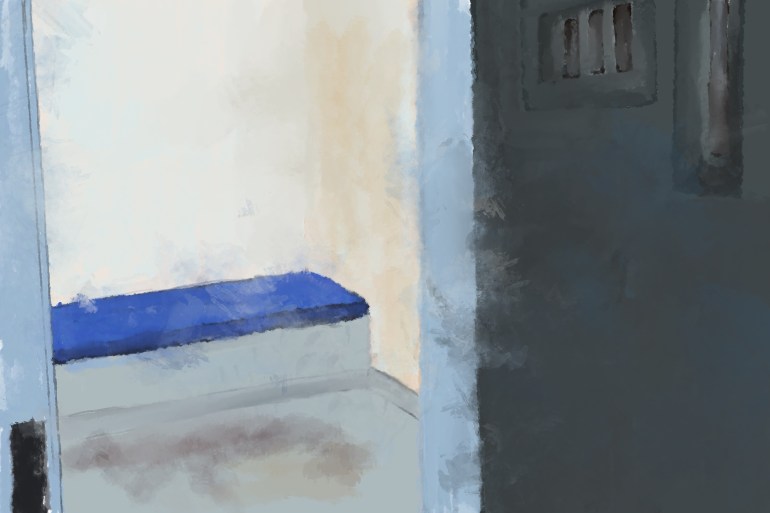The Indigenous people killed by police in Australia
After recent trials in which police officers have been acquitted, Indigenous Australians ask ‘when are they going to stop killing us’?

Warning: Aboriginal and Torres Strait Islander viewers are warned that the following article contains the names of deceased persons.
The response to the murder acquittal was as disparate as the distance between them.
Keep reading
list of 4 itemsHolding Up the Sky: Saving the Indigenous Yanomami tribe in Brazil’s Amazon
Indigenous people in Philippines’s north ‘ready to fight’ as tensions rise
Curfew announced for under-18s in Australia’s Alice Springs after unrest
Outside the Darwin courtroom in Australia’s far north, a stony-faced – yet relieved – white police constable was flanked by his defence lawyer and police union officials.
One-thousand-five-hundred kilometres (930 miles) south, in the small, remote community of Yuendumu, an Indigenous family was in mourning.
After a five-week trial in the Northern Territory supreme court, Police Constable Zachary Rolfe was acquitted of the murder of Indigenous teenager Kumanjayi Walker.
The decision in March sparked outrage and disappointment in Australia’s Indigenous communities, many of whom saw the acquittal as yet another injustice in a long colonial history of police violence against First Nations peoples.
Had the charges led to a conviction, Rolfe would have been the first police officer in the country’s history to be found guilty for the death of an Indigenous person.
In the weeks before the trial, Cheryl Axleby from Indigenous advocacy group Change the Record told Al Jazeera that she likened the significance of the trial to that of Derek Chauvin who was convicted in the United States last year for the murder of George Floyd.
“In the wake of the Black Lives Matter movement, we watched on as in the US Derek Chauvin was convicted and found guilty of the murder of George Floyd. This was one small step towards accountability,” she said.
“Here in Australia, we are still waiting for that accountability.”
Shot three times
Walker was fatally shot three times by Rolfe in November 2019 during an attempted arrest in Yuendumu.
Walker – who was 19 and from the Warlpiri people – had travelled to Yuendumu from Alice Springs to attend a funeral. But in doing so, he violated the terms of a suspended sentence he was serving, which required him to stay in the small central Australian town.
As a result, a warrant was issued for his arrest. A first arrest attempt by Yendumu police was aborted after Walker wielded a small axe, although officers later stated that they felt the gesture was more of an effort to get them to leave as opposed to a genuine threat.
However, three days later, a second arrest attempt was made by Rolfe and Constable Adam Eberl, part of the Alice Springs-based Immediate Response Team.
During the arrest, a scuffle ensued and Walker stabbed Rolfe in the shoulder with a pair of scissors. Rolfe responded by shooting him – three times.
While the first shot – which hit Walker in the back – was viewed by prosecutors as being within the line of duty, it was the two ensuing shots to the torso which were ruled by a coroner to be the fatal wounds.
Four days after the shooting, Rolfe was charged with murder.
Rolfe’s defence team told the court the 30-year-old former soldier who had served in Afghanistan had “no choice” but to shoot Walker and described the Indigenous teenager as being “the author of his own misfortune”.
However, the prosecution claimed that Rolfe had lied about aspects of the arrest to justify the shooting, including that Walker had his hand on his police service pistol, a claim the prosecution stated Rolfe’s body-worn camera did not support.
The court also heard that Rolfe had become “obsessed” with arresting Walker after the axe incident, and that there was confusion with regard to the arrest plan. Some witnesses claimed Walker had agreed to hand himself in to police after the funeral while others said Rolfe and the Alice Springs’ officers were told to arrest him as soon as possible.
Ultimately, the jury agreed with Rolfe’s legal team that the incident occurred within the line of duty, and he was acquitted.
It took the jury – which included no Indigenous people – seven hours to reach its verdict.
Along with being cleared of murder, Rolfe was also cleared of two alternative charges of manslaughter and engaging in a violent act causing death.
Northern Territory Police Association President Paul McCue defended the verdict, stating that “we held the view from the beginning, and still do today, Constable Rolfe simply followed his police training when confronted with that life-threatening situation. This was ultimately confirmed by the jury.”
Yet Walker’s family had remained hopeful of a guilty verdict.
“We are deeply saddened by the results and cannot begin to explain our grief in words. His death has affected our community in ways we could never have predicted,” their statement read.
“We as a family and community will continue to remember him as a young man who loved animals, who loved his community and homelands, his partner, his family, his friends, and loved music. A traditional Aboriginal young fella who loved hunting and being out on country.”
‘History repeating’
The Walker case ignited debate around Australia, with polarised camps either defending the constable’s actions or supporters rallying under the slogan ‘Justice for Walker’.
The case – and the verdict – also rest within the context of the long history of colonisation Indigenous Australians have endured, often under the hand of the police and criminal justice system.
Settled as a penal colony in 1788, the arrival of the British on the continent now known as Australia had a devastating effect on the 500-plus Indigenous nations who had been living there for more than 60,000 years.
Disease, massacres and the forced removal of Indigenous peoples from their lands were spearheaded by punitive police forces in what is now termed ‘the Frontier Wars’.
Police and prisons were systematically used over the next two centuries to reinforce British colonisation; police were involved in numerous massacres. Between 1869 to the early 1970s, they were also granted powers to remove Indigenous children from their families. Indigenous children were taken to missions or church-run orphanages or placed into white foster homes in order to be assimilated. They would become known as the Stolen Generations. Prisons were used to lock up Indigenous people who actively resisted the invasion of the colonisers and for those who took part in what the British considered ‘criminal’ acts such as ‘trespassing’ on their own traditional lands.
Studies have demonstrated that Indigenous communities continue to experience over-policing, leading to higher arrest rates, with a 2009 Australian National Council of Drugs report revealing that Indigenous people are up to 20 times more likely to be arrested than non-Indigenous Australians.
Such over-policing also increases the chance of incidents such as Walker’s shooting.
After the acquittal, Warlpiri Elder Ned Jampijinpa Hargraves publicly advocated for more Indigenous community services such as the Night Patrol, in which Indigenous people – not police – monitor the safety of the Yuendumu community. He also called for police to listen more to Warlpiri Elders and community members.
“We want a ceasefire. No more guns in our communities. It must never happen again. The police must put down their weapons. Instead of funding more police, redirect that money to yapa [Indigenous] community services like our Night Patrol,” he said in a statement.
“We want to assess any police coming into our community. They must listen to our elders, yapa liaisons and community. Police must respect our Warlpiri law and if they don’t we must have the power to evict them.”
Like many Indigenous peoples around Australia, the Warlpiri have been subjected to brutal treatment by police in the past.
In 1928, approximately 60 Warlpiri people were killed by a group of white men led by police constable George Murray in response to the death of a white dingo trapper.
In what is now known as the Coniston Massacre, the reprisal party killed men, women and children in various sites in the region over a period of several months.
No one was charged for the murders, and an inquiry established to investigate them ruled that the reprisal party had acted in self-defence.
Recent research demonstrates that about half of such massacres were led by police or government forces, with the effect still resonating within Indigenous communities today, leading to distrust and fear of police.
In his media statement, Hargraves likened Rolfe’s acquittal to the Coniston Massacre.
“In 1928, hundreds of our people were massacred by a policeman from Alice Springs, George Murray. He was also a returned soldier from WWI. His trial was sent to Port Augusta and he was acquitted. Is history repeating itself?” he asked.
‘The grim reality’
Two months before Walker was killed, an Indigenous woman was surrounded by police on a suburban street in the small Western Australian town of Geraldton. Agitated, she held a pair of scissors and a knife. The police had responded to a welfare call from the woman’s sister.
The last officer to arrive on the scene – and the most junior – drew his gun and fatally shot her in the stomach.
The woman, known publicly as JC, was from the Yamatji people. She was 29 years old and had a six-year-old son. She had experienced significant mental health and drug problems and had recently been released from prison.
After a three-week trial, the officer involved was acquitted of both murder and manslaughter. The jury had deliberated for three hours.

The only other known record of a police officer being charged with murder in the state of Western Australia (WA) came in the wake of the 1926 Forrest River Massacre, in which at least 20 Aboriginal people were killed by yet another police-led reprisal party.
Megan Krakouer, from the Noongar peoples, works for Australia’s National Suicide Prevention and Trauma Recovery Project. She told Al Jazeera that JC’s death could have been avoided.
“The majority of people we are seeing come into the prison system have low levels of education, a lot of unaddressed trauma and lack of mental health support,” she explained.
She says that many Aboriginal people have had such negative experiences “to the point where the Aboriginal person says I hate the police, I can’t stand the police, I don’t want a relationship with the police and f*** the police.”
Krakouer says that police who are working with Aboriginal communities need to be “immersed” in Indigenous culture to better understand First Nations peoples.
“Cultural awareness – that’s a given. It should happen irrespective when a person is being trained in the police academy,” she said.
“Those that have been harmed by police, those that have had negative experiences by police, those that have been incarcerated as a result of police contact – we are not hearing their voices. And if we are not hearing their voices we are not capturing the true grim reality.”
Krakouer also told Al Jazeera that police protocols when dealing with tense situations need to be revised.
“We need to step it up and examine the police protocols around training. Because in many situations, if a police officer feels like they are in danger, or their life is at risk, according to the manual they can shoot. That’s the reality. In terms of the Yuendumu incident – rest in peace – [Rolfe] could have stepped back. At what point does a person step back and de-escalate the situation?”
Being an Indigenous police officer: ‘Toxic and unsafe’
Veronica Gorrie is an Indigenous woman who knows intimately how bad relations between the police and Indigenous communities are.
“As an Aboriginal child I witnessed firsthand my family and my community being arrested by police,” she told Al Jazeera.
“And not just arrested but targeted, racially profiled and brutalised by police with police using excessive force. They were handcuffed and beaten by multiple police officers at the time.”
A former Queensland police officer, Gorrie – from the Gunai Kurnai peoples – has recently released a book titled Black and Blue detailing the racism and abuse she suffered during her 10 years in the force and the abuse other Indigenous people were also subjected to.
As she speaks on the phone to Al Jazeera, an innate strength is evident in her voice. Black and Blue has just won Australian literary awards, and she has appeared at numerous media events and literary festivals. While she admits at times that telling such a traumatic story can be exhausting, she also feels it is necessary to uncover the truth about the police institution.
She said such experiences, along with her own family’s history of children being removed from their parents as part of the Stolen Generations, created fear within her community.
It was one reason why she decided to become a police officer – in the hope that she could affect some change.
“I wanted to eradicate the fear that my people and my family had towards the police,” she explained.
“I thought the only way I could do this was to join the police. But after only serving just a short amount of time in the police these fears were well and truly justified.”
She says that she heard racist language on a daily basis and witnessed fellow officers’ demeaning behaviour towards Indigenous people.

Black and Blue describes how after the death of an Aboriginal man in prison in Queensland sparked riots in the community of Palm Island, police officers wore wristbands in support of the officer being investigated.
Gorrie also describes racism directed towards other minorities within the police force, such as the time a Tongan woman was talking excitedly about what to name her new baby and an officer joked ‘defendant’, to which the room erupted with laughter.
“They had racist slogans on the walls of the police station and racial slurs on photographs of Aboriginal people on warrants,” she said.
Gorrie also recalls that even after five years in the police force, if she met someone new she would have to explain she was Aboriginal within the first few minutes of conversation.
That way, she would hopefully avoid hearing racial slurs during her shift.
“I don’t know any other employment place where you have to do that. It was a toxic and unsafe space for me to be in.”
Gorrie decided to leave the police force in 2011 and was medically discharged. Today, she says she still suffers a range of health issues, including anxiety and PTSD.
Of the shooting of Kumanjayi Walker, Gorrie – who completed firearms training during her time in the police – told Al Jazeera: “There was no need to use a firearm in that incident.”
She says that while training in the academy, officers are told not to shoot to kill but are conversely trained to shoot where the main organs are. “So the risk of getting killed is very high.”
There are other options available to officers, such as capsicum spray and tasers “instead of going straight for the firearm,” she explained.
Of the verdict in the Walker case, Gorrie reflected: “When the colonisers came over it was set up for them. It was not designed for us. It was designed to enforce the legislation and laws onto us, so it is working. It’s a form of genocide with policing. I don’t think non-Indigenous people understand the sheer terror and fear we have of police. I just wonder when are they going to stop killing us?”
Deaths in custody
Police shootings of Indigenous peoples are closely linked to the ongoing issue of Indigenous deaths in custody.
Since a landmark Royal Commission report on Aboriginal Deaths in Custody was released in 1991, more than 500 Indigenous people have died in custody.
While compensation has been paid to families in some instances, none of the deaths have led to a guilty verdict of any police or prison staff involved, despite repeated coronial inquests.
The Royal Commission report included 339 recommendations to address the issue, many of which have never been implemented.
Despite making up just 3.3 percent of the total population, Indigenous adults make up more than 27 percent of Australia’s prison population.
As such, key recommendations of the report highlighted the need to reduce Indigenous incarceration. Yet, a 2018 Deloitte report found that only 55 percent of such recommendations – such as those designed to use jail as a last resort – have been implemented.
For young people, the situation is even more alarming with Indigenous children making up more than 55 percent of all youth in detention. Children as young as 10 are able to have criminal charges laid against them. Nationally, an Indigenous young person is 17 times more likely to go to prison than a non-Indigenous young person, with advocates campaigning for the age of criminal responsibility to be raised to 14.
In the Northern Territory – where Rolfe was tried – this statistic rose to 100 percent of children in youth detention being Indigenous in 2017, despite Indigenous people making up just 30 percent of the overall population.
Many Indigenous people behind bars are imprisoned for minor offences. For example, data compiled by the New South Wales (NSW) Bureau of Crime Statistics and Research between 2013 and 2017 showed that approximately 82 percent of all Indigenous people found with a non-indictable quantity of cannabis were pursued through the courts, compared with only about 52 percent for the non-Indigenous population, leading to more Indigenous people being caught up in the criminal justice system.
In 2014, 22-year-old Indigenous woman Ms Dhu died in police custody in the northwestern town of Port Hedland after being arrested and jailed for unpaid fines totalling 3,622 Australian dollars ($2,600). The fines had accumulated after a series of minor incidents, such as being charged for vagrancy for sleeping on a beach. After she failed to appear in court for these charges – during which the fines increased due to non-appearance penalties – she was arrested and taken to the police station in order to ‘pay off’ her debt through four days of prison time.
While in police custody, Ms Dhu complained of an injury that had been inflicted in a previous domestic violence incident. Video evidence showed that police assumed Ms Dhu – from the Yamatji people – was faking an illness and called her a “junkie”.
A doctor at the local hospital pronounced her fit for incarceration, and within 48 hours of being jailed, Ms Dhu died of septicaemia and pneumonia caused by an abscess in a broken rib.
A coroner’s inquest was critical of the response of both the police and medical personnel and found Ms Dhu had been treated in an “unprofessional” and “inhumane” manner.
Ms Dhu’s family eventually received compensation, while legislation that allowed people to be jailed for unpaid fines was overturned after a public outcry and a legal review.
The WA Department of Justice stated to Al Jazeera that, after Ms Dhu’s death, “imprisonment for non-payment of fines is now restricted so it can only be ordered by a Magistrate, and even then only as a sanction of last resort”.
In 2021, WA also introduced a new Aboriginal Justice Advisory Committee “to help identify improvements to initiatives, policies and strategies to help the Department of Justice achieve better outcomes for Aboriginal people”.
The Department also implemented a 24-hour custody notification system by which Aboriginal Legal Services are immediately advised of the arrest and detainment of any Indigenous person.
An original recommendation of the Aboriginal Deaths in Custody report, Custody Notification Systems (CNS) have proven in other jurisdictions to reduce mistreatment and death of Indigenous people in police custody, as Aboriginal inmates are able to access immediate welfare checks from community and legal services, and have the opportunity for legal representation immediately after their arrest. In NSW, for example, no Indigenous person has died in police custody since CNS was implemented in 2000.
WA Attorney General John Quigley was quoted as saying, “Ms Dhu should never have been in custody and she should never have died in custody. Had there been a custody notification service in place, I believe that her tragic death in custody would have been avoided”.
However, despite these legislative and systemic amendments, no charges were laid against any of the police involved in Ms Dhu’s death, while the doctor who certified her fit for incarceration was fined 30,000 Australian dollars ($21,500).
‘We need to fight for our loved ones’
The failure of the criminal justice system has meant that Indigenous communities are often left to deal with the effect of such deaths on their own.
In 2018, 55-year-old Yorta Yorta woman Tanya Day died in police custody after being arrested for public drunkenness and then falling and hitting her head in a police cell.
An inquiry was launched to determine whether systemic racism was at the root of her arrest.
Her daughter, Apryl Day, launched the Dhadjowa Foundation, an Indigenous-led organisation that aims to support family members of Indigenous people who have died in prison or police custody.
Dhadjowa, meaning ‘sunshine’ in Yorta Yorta language, is a reference to her mother’s spirit, Apryl says.
“I just really wanted to create something that ensured that families were supported,” she said. “And to ensure that we were doing something that could help [families] during the most difficult time of their life.”
The Dhadjowa foundation describes its purpose as supporting families who “experience the injustice of Black deaths in custody”. Such families “must deal with a whole range of procedural, media and campaigning issues, as well as legal decisions, at a time when they are still grieving and in shock. This creates great financial strain at an already difficult time.”

The financial strain of deaths in custody is often only relieved by crowd-funding platforms or from community services such as Dhadjowa.
Day describes the process of dealing with a family member’s custodial death as “constantly fighting” against an unjust and uncaring system.
“We all need to fight for our loved ones and fight for them to be seen as an actual person and not a statistic,” she said.
Apryl also says that since 30 years have now passed since the Royal Commission and custodial deaths continue to take place, it had been a “complete failure”.
“The failure to implement those recommendations puts our loved ones at risk,” she said, adding that the failure to decriminalise public drunkenness – one of the original recommendations – led directly to her mother’s death.
‘Racism kills’
Australia’s brutal colonial past means such deaths are often viewed by Indigenous communities as being racially charged.
“There is a direct causal link between the racism, the discrimination, the attitude and the classism that exists when policing Aboriginal people in their communities,” Megan Krakouer explained.
Back in Yuendumu, Valerie Napaljarri Martin, deputy chair of the Warlpiri Yuendemu Parumpurru select committee, called for an end to racism and for more control and self-determination to be placed in the hands of Indigenous people.
“We are all connected in this country, we should not be divided by racism but we are,” the Warlpiri Elder’s statement read.
“We need control back in our communities so we can deal with the problems that are there. The biggest problem we have is racism in the police and racism in the court system and racism kills. Racism killed Kumanjayi Walker.”
The Northern Territory Department of Justice and Northern Territory Police, Fire and Emergency Services declined to comment.
WA Police Force, Queensland Police Service and the Police Federation of Australia did not respond to a request for comment.